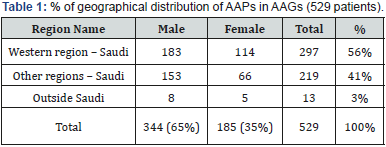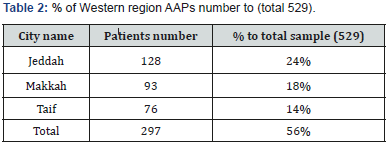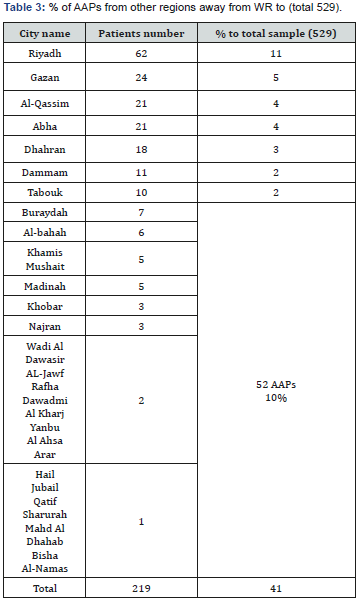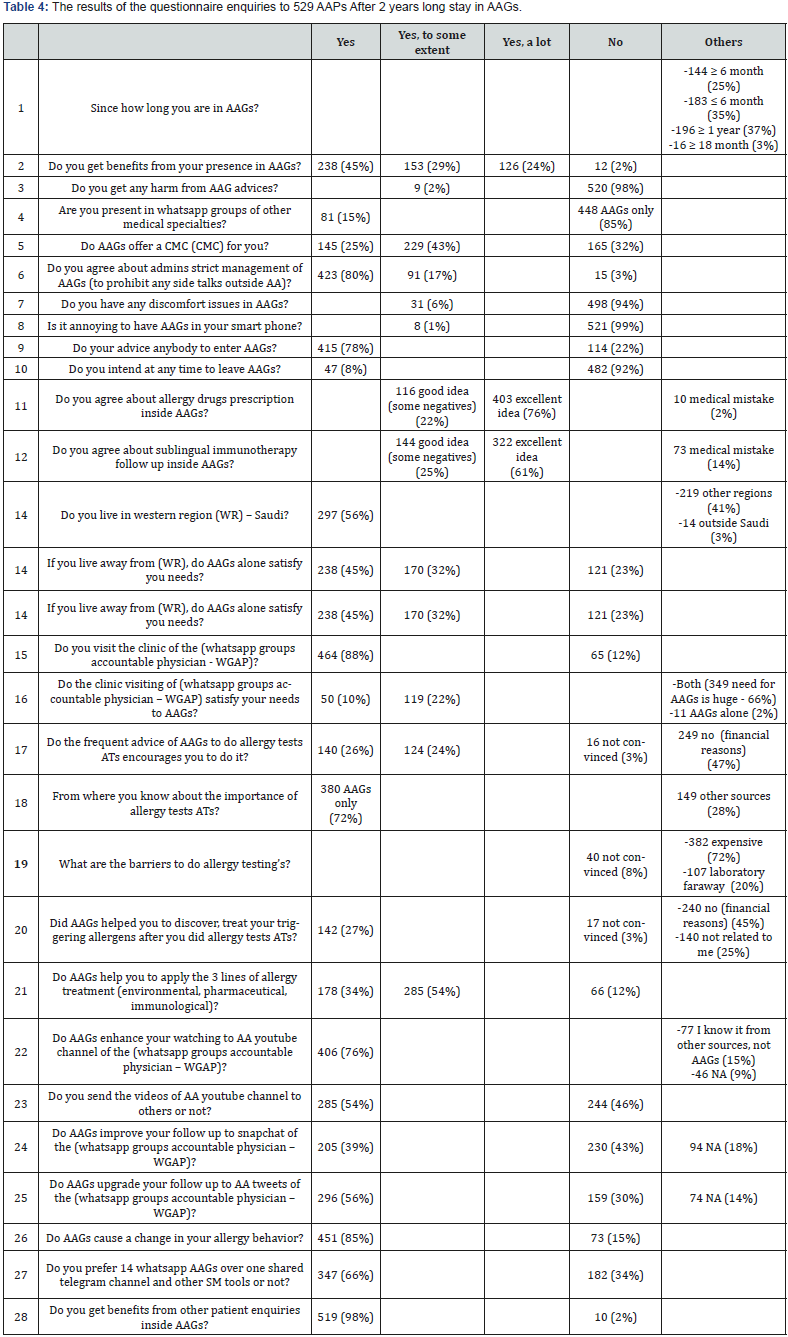Whatsapp Education for Asthma and Allergy Patients: Pros and Cons
Moufag Mohammed Saeed Tayeb*
Consultant, Associate Professor Family Medicine (Allergist), Faculty of Medicine, Jeddah University, Saudi Arabia
Submission: December 19, 2018; Published: January 10, 2019
*Corresponding author: Moufag Mohammed Saeed Tayeb, Consultant, Associate Professor Family Medicine (Allergist), Faculty of Medicine, Jeddah University, Saudi Arabia
How to cite this article: Moufag Mohammed Saeed Tayeb. Whatsapp Education for Asthma and Allergy Patients: Pros and Cons. Glob J Oto, 2019; 18(5): 555999. DOI: 10.19080/GJO.2019.18.555999
Abstract
Background: smartphones (SMPs) and social media (SM) are worldwide. Whatsapp is the best program for education, considered as a major advance in health education.
Objective: to measure asthma, allergy patients (AAPs) satisfaction after whatsapp education.
Methods: a cross-sectional, Gmail electronic questionnaire (EQ) study on 529 adult AAPs (344 males, 185 females). EQ is composed of 28 questions about AAPs satisfaction after whatsapp education. EQ was distributed and collected from 14 whatsapp asthma, allergy groups (AAGs). AAGs worked for 2 years of asthma, allergy (AA) education (April 2016 to April 2018).
Results: 1-APPs opinion: 60% stay≤1 year, 37%≥1 year, 98% get helps when need with no harm, 94% no discomfort, 99% no annoying issues, 92% don’t intend to leave, 98% benefited from other enquires, 78% advised others to inter AAGs, 68% get continuous medical care (CMC) 2-public awareness: 15% APPs in several medical whatsapp groups (MWGs), 85% in AAGs only 3-AAGs management: 97% support strict management 4-Drugs prescription, SLIT FU in AAGs: 98%, 86% support drugs prescription, SLIT FU respectively 5-APPs living place: 97% from Saudi 6-Clinic vs whatsapp care: 88% visited clinic, 66% combine 2 services (live near the clinic), 77% use AAGs alone (live away from clinic) 7-Barriers to do ATs: 72% financial issue, 28% not aware, 20% away from the lab 8-Medical SM awareness: 76% aware about youtubes of whatsapp groups accountant physician (WGAP) from AAGs, 15% other sources, 54% send youtubes to others, 56% follow WGAP tweets, 39% follow WGAP snaps 9-Behavioral change: 85% changed behavior in AAGs, 15% didn’t.
Conclusion: SMPs use is huge, it’s a real advance in medical care. Whatsapp is the best SM program for health education (HE) of APPs and CDs because they need a long-term care. CMC in whatsapp groups do improve patients knowledge and behavior. However, whatsapp medical care have a lot of uncertainties which need more research.
Keywords: Asthma; Allergy, Whatsapp; Social Media; Smartphones; Health Education; Medical Care; Cds; Health Professionals; Patients
Introduction
HE is a central issue in medical field specially for CDs care because they need HE for longtime. AAPs need HE on many areas like: inhalers technique, compliance, regular FU visits…etc. HPs need several skills to become expert and can deliver messages optimally. Communication skills are vital during HE process. The main goal from HE is to change patients practice and behaviors not to deliver information’s only [1]. Globally, SMPs are the commonest used device for communication. This huge spread makes it one of the crucial ways for medical service. This electronic revolution should improve health care when used properly. Additionally, its cheap price makes it more accessible in developing countries. SMPs are the best for education because they are practical, effective and free. However, this area needs full medical research and guidelines [2].
SM programs are an actual uprising in communication with patients but with a lot of uncertainties. In a review study conducted in 2014, four advices framed about use of SM: always be professional, just go on with no fear, always seek assistance and constantly concentrate on your aim. However, still there are many vague areas in the relation of SM with medical field which needs further research [3]. Worldwide, whatsapp is the commonest used SM program. Its use in medical HE is great but with a lot of doubts. In a review study conducted in south Africa in 2016, many articles were revised and show that HPs who use whatsapp don’t think a lot about confidentiality, consent nor data privacy. Patients’ rights and medical ethics are at a real challenge with whatsapp use! This dilemma increase as the patients are more interested in whatsapp medical service more than anything else! The current fact is that, this field is recent with few research only [4].
Chronic diseases (CDs) create a major burden on health system, considerable morbidities and complications if not treated properly. AA diseases are CDs which presents mostly in primary care. Nevertheless, there are limitations in AA in primary care like: low awareness, underdiagnosis, undertreatment, and high comorbidity. HE is considered as the main solution to avoid these drawbacks. In this article, whatsapp education of AAPs is a new expert which needs publication [5]. AAGs are 14 whatsapp groups work to answer AA questions only and AAPs do enter AAGs through advertised electronic links. Any questions in other specialties are referred to the suitable specialist. AAGs receive AA questions continuously (24 hours/day). Respectively, the commonest AA questions are about: allergic rhinitis, allergic sinusitis, asthma, atopic dermatitis, urticarial, food allergy, drug allergy and anaphylaxis. Regularly, questions are answered by WGAP once or twice daily. Answering tools are: writing chat, voice chat, photos, pamphlet’s and other SM tools like (youtube videos, tweets, instagram and snaps).
Method and Materials
A cross sectional EQ based study, composed of 28 questions using Gmail system. EQ was done in 14 whatsapp groups specialized in AA after 2 years of continuous education (from April 2016 up to April 2018). Total collected participants sample was 529 adult AAPs: 344 males, 185 females. Comprehensively, EQ questions do cover many areas related to APPs care. EQ main theme is to ask about the benefits, harms and feelings of AAPs from their presence in AAGs and their satisfaction level from this service. Additionally, EQ examine the intention of APPs to leave or stay in AAGs through 2 years period, if they advise others to inter AAGs or not. Moreover, EQ focus if AAGs offer CMC or not? Furthermore, EQ test APPs opinion about allergy drugs prescription and SLIT FU in AAGs. Geographical APPs living place was an issue: if they live in western region – Saudi (WR) or away from it? Comparing the 2 services value (visiting WGAP clinic, AAGs) to AAPs was a subject also. ATs are an important group of EQs: barriers to do it, financial issues and APPs convincement. Likewise, the application of the 3 lines of allergy management was a query also. Finally, the impact of AAGs on AAPs FU to the SM facilities of WGAP was a topic also. Collection of EQ voting by APPs was preceded by frequent advertisements in AAGs for one month. EQ link was distributed in AAGs at the same time on Friday evening, 20th April 2018. With continuous encouragement by WGAP and admins, participation was gradually increasing through one week of voting collections. Arbitrarily, only 15% AAPs in AAGs share in voting because total suspected APPs number in all 14 AAGs is 3584 patients. EQ answers were collected in excel sheet and presented by tables. To our knowledge, this is the first EQ based cross sectional study about the satisfaction level of AAPs in whatsapp groups after two years of constant education.
Results
Total AAPs sample who participate in EQ are 529: 344 (65%) males, 185 (35%) females. Almostely, ½ AAPs live in western region – Saudi (56%), while the other ½ live in other regions – Saudi (41%). Minority are from outside Saudi (3%) (Table 1). APPs from WR (Saudi) who share in EQ are 297 patients (56%). The maximal number is from Jeddah 128 patients (24%), followed by Makkah 93 patients (18%), then Taif 76 patients (14%) (Table 2). AAPs from other regions of Saudi who join EQ are 219 patients (41%). AAPs who participate are as follow: Riyadh 62 (11%), Gazan 24 (5%), Al-Qassim 21 (4%), Abha 21 (4%), Dhahran 18 (3%), Dammam 11 (2%), Tabouk 10 (2%). All other cities total participants are 52 APPs (10%) (Table 3).




The results of EQ of 529 AAPs in AAGs through 2 years education are summarized as follow (Table 4):
1. AAPs stay for longtime in AAGs: 6month–1 year (60%), 1 year–18 month (37%), ≥18 month (3%).
2. Almostely, all AAPs agree they get benefits after (18 month stay) in AAGs (98%), while minority only who disagree (2%).
3. Almostely, all AAPs disagree that AAGs cause any harm to them after (18 month stay) in AAGs (98%), while minority who agree (2%).
4. Majority of AAPs are present in AAGs (85%), few presents in other WMGs (15%).
5. 2/3rd APPs approve that AAGs offer CMC (68%), while 1/3rd disapprove (32%).
6. Almostely, all AAPs agree about the strict management of AAGs (97%), minority disagree (3%).
7. Almostely, all AAPs don’t have discomfort after (18 month) stay in AAGs (94%), few have (6%).
8. Almostely, all AAPs don’t feel annoyed from AAGs in their SMs (99%), minority feels (1%).
9. 4/5th APPs do advice others to inter AAGs (78%), 1/5th don’t (22%).
10. Almostely, all AAPs don’t need to leave AAGs through 18 months (92%), minority do (8%).
11. Almostely, all AAPs agree about allergy drugs prescription inside AAGs (98%). However, this number is divided into 2 parts: those who believe totally (76%), those who believe but with some drawbacks (22%), minority claim this as a medical mistake (2%).
12. Majority of AAPs agree about SLIT FU in AAGs (86%), but they are divided into 2 parts: those who believe totally (61%), those who believe but with some drawbacks (25%). The remaining few AAPs claim it as a medical mistake (14%).
13. Almostely, all AAGs are from Saudi (97%). They are divided into 2 equal parts: those from WR (56%) and those from other regions (41%). APPs out of Saudi are minority (3%).
14. 4/5th AAPs who live away from WR are satisfied from AAGs alone (77%), while 1/5th aren’t (23%).
15. Most AAPs in AAGs have visited WGAP clinic (88%), while minority didn’t (12%)
16. 2/3rd AAPs prefer to combine the 2 medical care’s together (WGAP clinic and AAGs) (66%), while the remaining 1/3rd prefer WGAP clinic alone (32%). However, those who prefer AAGs alone are minor (2%).
17. Almostely, all APPs are convinced to do ATs after AAGs advices (97%). However, convincement alone isn’t a full reason to do ATs because (50%) of them really did it, while (47%) of them didn’t due to financial reasons (47%)!! Those who aren’t convinced are minor (3%).
18. 2/3rd AAPs knew about ATs value from AAGs alone (72%), while the remaining 1/3rd knew about ATs from external sources (28%), This fact can reflect the unacceptable low level of awareness about ATs value (in discussion).
19. 2/3rd APPs specify the financial issues as the main barrier to do ATS (72%). The remaining 1/3rd is divided into 2 parts: those who state the barrier is the big distance from the nearest lab (20%) and those who are not convinced to do it (8%).
20. Unfortunately, 1/4th of APPs only who really discovered and treat their triggers after AAG advices (27%). The remaining 3/4th state the following reasons not to do ATs: financial issues (45%), misunderstandings (ATs not related to them) (25%), not convinced (3%).
21. Majority of AAPs have applied the 3 lines of allergy treatment after AAG advices (88%). Few didn’t (12%).
22. 3/4th AAPs know about WGAP youtube channel from AAGs only (76%). The remaining 1/4th is divided into 2 parts: who recognize from other sources (15%), who misunderstand (not applicable on them) (9%).
23. ½ AAPs do send the videos of WGAP youtube channel to others (54%) while other ½ don’t (46%).
24. After 2 years education in AAGs, 1/3rd AAPs follow WGAP snaps about AA (39%). The remaining 2/3rd is divided into 2 parts: who didn’t (43%), who misunderstand (not applicable on them) (18%).
25. After 2 years education in AAGs, ½ AAPs follow the daily WGAP tweets about AA (56%). The other ½ is divided to 2 parts: who didn’t (30%), who misunderstood (not applicable for them) (14%).
26. Thankfully, AAGs have changed allergy behavior of most AAPs after 2 years education (85%). Only (15%) who didn’t.
27. 2/3rd AAPs prefer whatsapp over telegram (66%) and other SM tools, while the remaining 1/3rd prefer telegram (34%).
28. Inside AAGs, almostely all AAPs are benefited from other AAPs queries, minority didn’t (2%).
Discussion
Discussion
Currently, SMPs use resembles an addiction (mainly in whatsapp). Unfortunately, studies in this area are still few. In a study done in 2015, a big sample of 2,418 SM users were collected and show (161.95 minutes) SMPs using time use per 4 weeks! From this time (19.83%, 9.38%) were for whatsapp and facebook respectively. These findings confirm that SMPs use is a major daily practice and whatsapp is the commonest SMPs used program [6].
SM use in medical field is growing quickly, however research in this area is limited. In a study conducted in USA in 2012, EQ was emailed to 1196 pharmacists about this issue to discover their ideas. Participations rate was 23.7% (248 pharmacists), they show that: 98% have internet accesses in their pharmacies, 91% oriented about SM, 56% use emails, 34% use text messages. These findings mean that HPs are ready to use SM to communicate effectively with patients [7]. Moreover, patient’s affiliation and electronics use aren’t related together. In a study done in 2014, low income families were tested for their use of electronics. A cross sectional study using survey questions on 806 parents from poor families have showed that their use of internet, text messages and SMPs was more than 60%. This means that poor families are well oriented about electronics, the fact which facilitates an easier electronic communication with them [8]. However, HPs were hesitant to enroll electronic services in medical care because they are afraid of abuse by the huge number of unpaid messages! Inappropriately, they think this will put a huge burden on them. In Lederman’s study done in USA in 2005, the objective was to measure the effect of the email contact with patients on primary care settings. Results show that email is preferred to patients because it is secure and considered as an official document [9].
Whatsapp use in medical care, is it an evidence based or not? In a literature review conducted in South Africa and published at 2016, many concerns were raised about whatsapp use in medicine like: confidentiality, data safety and record protection. Many websites were revised about (whatsapp in clinical practice) and 32 papers were found. Summary illustrates that whatsapp is an efficient way of communication in health care and its use will advance quickly, however areas of concern need solutions [10]. Whatsapp use in patient’s education, is it an area of fear or not? In a south African primary care study in 2015, EQ was collected from 21 undergraduate nurses to explore their reflections about whatsapp role. Results display an excellent impression about whatsapp characters. Whatsapp has presented a high significant chance for explanation to patients. Additionally, whatsapp groups revealed a great value also [11]. Currently, whatsapp is the most preferred SM program for patient’s education, however this wasn’t the picture before several years only. In Alan’s study in 2011 which was done in USA, this preference to whatsapp happened in few years only because in 2011 the best ways of electronic contact with 145 asthmatic patients were: emails, test messages, facebook and twitter respectively. This rapid shift clarifies the great characters of whatsapp in this field [12].
In a local study about whatsapp: Saudi medical residents get an enormous assistances from whatsapp. In a cross sectional study in 2016, 143 residents from 17 specialties were enrolled in a web based questionnaire about whatsapp. Results indicated that 100% agreed on cooperation with their hospitals via their mobile phones, 87.1% were whatsapp users and 64.4% were communicating via whatsapp. These results revealed that mobile phones and whatsapp become a vital tool to be used by medical residents [13]. Medical Whatsapp groups (MWGs) are useful in medical communication between HPs. In EQ in 2016 on 84 HPs: 97.62 % are oriented about whatsapp, 86.9 % share MWGs with their colleagues, 28.57 % like medical discussions inside MWGs and 66.67 % like to debate about their research work in MWGs. Allover, MWGs are used for discussions more than patient’s treatment by HPs [14]. Additionally, whatsapp don’t affect the learning level of medical students in spite of its extensive use! Recent Saudi study was conducted in 2018 on 160 medical students to explore the effect of whatsapp on their academic performance. Results revealed that 99% use whatsapp with no effect on their accumulative marks. However, the study advises to downsize the whatsapp use to avoid an addiction [15].
2-New Evidence in My Current Study
Patients need MWGs to receive continuous electronic care. In my current study about AAGs: 60% APPs continued in AAGs less than 1 year, 37% more than 1 year, 98% APPs get a lot of helps and don’t complain from any harm. 94% don’t have any discomfort, 99% no annoying issues, 92% don’t intend to leave. Additionally, 98% AAPs are assisted from other patient enquires and 78% APPs have advised others to inter to AAGs. These results support the patients demand to a whatsapp professional specialized services like this. Unfortunately, HPs aren’t encouraged to supervise whatsapp groups to avoid unpaid abuse. That’s why MWGs are not commonly available. In my study, just 15% APPs are found in several MWGs, 85% in AAGs only. Moreover, 68% AAPs emphasize that they get CMC from AAGs. These results clarifies the big gap between patient needs and HPs convection. The best source of paid picture are the advertisement companies. Health sector have to solve this issue in win-win situation. MWGs have to be managed strictly otherwise benefits will be decline because of the subjects not related. This way will create a continuous distraction that will decrease groups credibility level and patients will start to escape out. In this study, 97% of APPs agree about this strict management of AAGs. In AAGs no subjects except AA is allowed, 3 warnings are given to any talk outside AA followed by direct removal.
In MWGs, is it allowed to prescribe AA drugs and to do SLIT FU? it’s an area of uncertainty. In this study 98%, 86% APPs emphasizes on the benefits of AA drugs prescription and SLIT FU in AAGs respectively. However, do we consider the patients preference as a complete evidence or not? Where is the cut line? Certainly, this needs more research to clarify these issues. Nevertheless, the prescribing physician have to weigh pros and cons all the times. Which is more favored for patients: the clinic visits or whatsapp care? In this study, 66% APPs living near WGAP clinic (in WR) like to combine the 2 services together. While, 77% APPs living away from WGAP clinic (outside WR) are satisfied from AAGs alone. These results clarify that it depends on the distance from the clinic. It’s an additional advantage to whatsapp because HPs can afford education regardless of the distance. AAGs introduce its education to Saudi citizens mainly as 97% APPs are from Saudi. Why patients aren’t encouraged to do ATs in spite of its vital rule in diagnosing and treating their triggers? Answer: due to 3 barriers: financial issues, distance from laboratories and low awareness about ATs. In this study, 72% financial issues, 20% big distance from laboratories. Third barrier is the low awareness about ATs, 72% APPs aren’t aware and knew about ATs from AAGs only! Amazingly, patient’s convincement isn’t a barrier because only 3% APPs aren’t convinced.
Solutions of ATs underuse: First: control of ATs price in private sector, plus to be under insurance system. Second: offer ATs service in governmental hospitals and primary care settings. Third: media advertisements to raise public awareness about ATs. Fourth: regular educational courses for HPs and patients. This study show that 27% APPs did ATs before AAGs education, while 88% did it after 2 years of AAGs education. Nonprofessional SMs which provide medical education in Arabic language are many, however professional ones are few. Unfortunately, patients aren’t aware about the professional ones, but if they will stick if they become aware. In this study, 76% APPs become aware about AA you tube videos from AAGs only, 15% from other sources, 54% APPs send these videos to others. 56% APPs follow WGAP AA tweets, 39% APPs follow WGAP AA snaps. This happen after they become aware from AAGs only. Main goal of HE is to change behavior not to deliver knowledge only. Allergy behaviors which needs a change: regular clinic visits, doing allergy tests, application of the 3 allergy management lines together, good compliance, proper inhalers technique etc. in this study, 85% AAPs have changed their behavior after 2 years education in AAGs while only 15% who didn’t.
Conclusion
SMPs use is enormous, it’s a real development in medical care. Whatsapp is the best SM program for HE of AAPs in particular and CDs in general because they need a longtime care. Continuous medical education in whatsapp groups do improve patient’s knowledge and behavior. However, whatsapp medical care have a lot of uncertainties which needs more research.
References
- (2000) Core Educational Guidelines (Patient Education). American Family Physician.
- Jonathan Mayes, Andrew White (2016) How Smartphone Technology Is Changing Healthcare in Developing Countries. The Journal of Global Heath.
- Grajales FJ, Sheps S, Ho K, Novak-Lauscher H, Eysenbach G (2014) SM: a review and tutorial of applications in medicine and health care. J Med Internet Res. 16(2): e13.
- Mars M, Scott RE (2016) WhatsApp in Clinical Practice: A Literature Review. Stud Health Technol Inform (231): 82-90.
- Lenaeus MJ, Hirschmann J (2015) Primary Care of the Patient with Asthma. Med Clin North Am 99(5): 953-967.
- Montag C, Konrad Błaszkiewicz, Rayna Sariyska, Bernd Lachmann, Ionut Andone (2015) Smartphone usage in the 21st century: who is active on WhatsApp? BMC Res Notes (8): 331.
- Shcherbakova N, Shepherd M (2014) Community pharmacists, Internet and SM: an empirical investigation. Res Social Adm Pharm 10(6): 75-85.
- Swindle TM, Ward WL, Whiteside-Mansell L, Bokony P, Pettit D (2014) Technology use and interest among low-income parents of young children: differences by age group and ethnicity. J Nutr Educ Behav 46(6): 484-490.
- Liederman EM, Lee JC, Baquero VH, Seites PG (2005) Patient-physician web messaging. The impact on message volume and satisfaction. J Gen Intern Med 20(1): 52-57.
- Mars M, Scott RE (2016) WhatsApp in Clinical Practice: A Literature Review. Stud Health Technol Inform (231): 82-90.
- Willemse JJ (2015) Undergraduate nurses reflections on Whatsapp use in improving primary health care education. Curationis.
- Baptist AP, Thompson M, Grossman KS, Mohammed L, Sy A, et al. (2011) Text messaging, and email-preferences of asthma patients between 12 and 40 years old. J Asthma 48(8): 824-830.
- Jamal A, Temsah MH, Khan SA, Al-Eyadhy A, Koppel C, et al. (2016) Mobile Phone Use Among Medical Residents: A Cross-Sectional Multicenter Survey in Saudi Arabia. JMIR Mhealth Uhealth 4(2): e61.
- Varun A, Kothai A (2016) Communications Through WhatsApp by Medical Professionals. Indian J Surg 78(5): 428.
- Alkhalaf AM, Tekian A, Park YS (2018) The impact of WhatsApp use on academic achievement among Saudi medical students. Med Teach 40(Supply-1): 10-14.





























